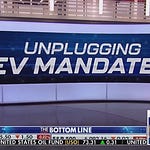Can Congress Undo The Electric Vehicle Mandate in the Future?
By Lauren Fix
Imagine a future where electric vehicles (EVs) dominate America’s roads, slashing emissions and reshaping transportation. Now picture that vision halted by a single congressional vote, only to spark a fierce battle to bring it back. In 2025, the Congressional Review Act (CRA) was used to overturn California’s ambitious EV mandates, a move that nullified strict emissions standards and set a high bar for their revival. But what would it take to undo this decision and restore the push for EVs?
What would it take to undo this decision and bring EVs back to the forefront? This complex journey through politics, law, and public pushback is worth your full attention. This fight matters to every American.
The CRA Roadblock: What Happened and Why It’s Tough to Reverse
In early 2025, the U.S. Senate voted 51-44 to use the CRA to strike down the Environmental Protection Agency’s (EPA) waivers that allowed California to enforce its Advanced Clean Cars II program. This program aimed for 35% of new vehicle sales to be zero-emission by 2026, scaling to 100% by 2035. The CRA, a powerful tool signed into law in 1996, lets Congress nullify federal agency rules with a simple majority vote, and once a rule is gone, the agency can’t issue anything “substantially similar” without new congressional approval. Signed by the president, this resolution stopped California’s EV mandates in their tracks and barred the EPA from reinstating similar rules.
Why does this matter? California’s standards don’t just affect the Golden State, 11 other states and Washington, D.C., adopted them, influencing nearly 40% of the U.S. auto market. The CRA’s action sent shockwaves through the EV industry, environmental groups, and state governments. Undoing this ban is no simple task, but it’s not impossible.
Path 1: New Congressional Authorization - The Legislative Longshot
The most direct way to restore an EV mandate is for Congress to pass new legislation explicitly allowing the EPA to issue similar rules. This would require a bill to clear both the House and Senate, likely needing just a simple majority (unless the Senate filibuster comes into play), and then land on the president’s desk for a signature. Sounds straightforward, right? Not so fast.
In today’s polarized Congress, getting bipartisan support for EV mandates is almost impossible. The 2025 Senate vote saw even some Democrats, like Michigan’s Sen. Elissa Slotkin, join Republicans to kill the EPA waivers, reflecting concerns from auto-heavy states where EVs are seen as costly or impractical for rural drivers. Auto industry groups, like the Specialty Equipment Market Association (SEMA), supported the CRA vote, arguing it protects consumer choice and avoids forcing unready technology on buyers. Meanwhile, environmentalists and states like California argue EVs are critical to meeting climate goals.
To pass a new law, a future administration would need unified control of Congress and the White House - think 2029 or beyond, depending on election outcomes. Even then, they’d face lobbying from oil, agriculture, and auto sectors, plus skepticism from regions where EV infrastructure (like charging stations) lags. The Infrastructure Investment and Jobs Act (IIJA) and Inflation Reduction Act (IRA) have poured billions into EV chargers and tax credits, but public sentiment still wavers - only 31% of Americans in a 2025 Pew poll said they’d consider buying an EV. A new law would need to bridge these divides, perhaps by offering more flexible incentives rather than strict mandates. Can Congress pull it off? Keep reading to see what else is in play.
Path 2: A New Rule That Dodges the CRA Trap
If Congress won’t budge, a future administration could try crafting a new EV rule that’s different enough from the overturned one to avoid the CRA’s “substantially similar” ban. For example, instead of California’s 100% zero-emission goal by 2035, the EPA could propose a rule emphasizing hybrids, plug-in hybrids, or alternative fuels, with softer targets or longer timelines. This approach keeps the spirit of emissions reduction without directly mimicking the nullified mandate.
Here’s the catch: opponents, like automakers or fossil fuel groups, could sue, arguing the new rule is still too close to the original. Courts would get involved, and the outcome hinges on the judges’ interpretations of “substantially similar,” a vague term that’s sparked legal debates before. In 2021, when the Biden administration tried to restore some Obama-era fuel standards, critics challenged them as too similar to rules previously axed by the Trump administration. A future EPA would need to be clever, maybe focusing on incentives over mandates or tying rules to broader air quality goals. This path is a tightrope walk, but it’s one worth watching.
Path 3: Legal Challenges - Can California Win in Court?
California isn’t going down without a fight. The state’s Attorney General has already promised lawsuits, arguing the CRA was misused because the EPA’s waivers weren’t “rules” but “adjudicatory orders” under the Clean Air Act. This distinction matters - the CRA only applies to rules, and in 2025, both the Government Accountability Office (GAO) and the Senate parliamentarian agreed the waivers didn’t qualify. Yet the Senate ignored this advice, setting a controversial precedent.
If California’s lawsuits succeed, courts could reinstate the waivers, effectively undoing the CRA’s impact. This happened in 2017 when a federal court overturned a CRA resolution that had nullified a methane emissions rule, citing procedural errors. But courts are unpredictable, especially with a judiciary increasingly skeptical of agency power. A win for California could restore its EV standards and inspire other states, but a loss would cement the CRA’s blockade. This legal drama could be the wildcard.
Path 4: Executive Action - Working Around the Edges
Even without Congress or courts, a future administration could push EVs through executive actions that don’t directly challenge the CRA. For instance, the EPA could tighten other emissions standards not tied to the overturned waivers, indirectly encouraging EV adoption. The Biden-era IRA offers up to $7,500 in tax credits for EV buyers, and the IIJA funds thousands of new charging stations - both untouched by the CRA. A savvy president could double down on these, funneling grants to states or automakers to boost EV production and infrastructure.
This approach has limits. It can’t restore California’s specific mandates, and aggressive moves might draw accusations of sidestepping Congress, inviting pushback from lawmakers or industry. Still, it’s a practical way to keep EVs in the game while other battles play out. Imagine a future where every small town has fast chargers - possible, but it’ll take time and money.
Path 5: States Take the Wheel
California and its 11 allied states (like New York and Massachusetts) aren’t helpless. They can still enforce EV policies not reliant on federal waivers, though the CRA’s nullification limits their scope. For example, California could offer state-level tax breaks or rebates for EV buyers, as it’s done before. Other states could follow, creating a patchwork of pro-EV policies. But without federal backing, their impact shrinks - California alone can’t match the market sway of a national mandate.
If California’s lawsuits succeed, states could regain broader authority. Until then, they’re fighting with one hand tied behind their backs. This state-level grit is inspiring, but it’s a reminder of how much federal support matters.
The Bigger Picture: Why This Fight Matters
Undoing the CRA’s EV mandate ban isn’t just about cars - it’s about America’s energy future, climate goals, and political power. EVs cut greenhouse gas emissions, which transportation accounts for 29% of in the U.S. (EPA, 2024). Restoring mandates could accelerate the shift to cleaner energy, but it’s not a slam dunk. EVs still cost more upfront - about $10,000 more than gas-powered cars on average (Kelley Blue Book, 2025) - and charging networks need to triple to meet demand by 2030 (Department of Energy). Rural areas, where 20% of Americans live, often lack chargers and see EVs as impractical for long hauls.
On the flip side, the CRA vote reflects real concerns. Automakers warn that rapid EV mandates strain supply chains, especially for batteries, and limit consumer choice. Rural voters and oil-producing states like Texas argue EVs don’t fit their needs. The 2025 vote showed bipartisan unease, with swing-state Democrats wary of alienating workers in auto or fossil fuel industries. Any push to undo the CRA must address these voices, perhaps through hybrid-friendly policies or massive infrastructure investments.
What’s Next? Timing and Politics
Timing is everything. The CRA’s 60-day review window means a new administration in, say, 2029 would need to act fast - proposing new rules or legislation before a new Congress shifts the political landscape. Control of Congress is key; a divided government could stall progress. Public support will also matter. If EV prices drop (as projected by 2027) and chargers become as common as gas stations, voters might demand stronger policies. But if gas prices stay low or battery shortages persist, resistance could harden. This chess game of power will shape what’s possible.
Why You Should Care - and Share This Story
This isn’t just a policy debate - it’s about our personal freedoms, the cars we drive, and the future we leave our kids. Undoing the EV mandate ban would require a mix of grit, strategy, and luck: a new law, a clever rule, a court win, or creative executive action. Each path faces hurdles, from polarized politics to legal gray zones to consumer skepticism. Yet the stakes are huge - cleaner air, energy independence, and a shot at slowing climate change.
In summary, undoing a CRA resolution to restore an EV mandate requires either new congressional legislation, a carefully crafted new rule, successful legal challenges, or alternative executive actions. Each path faces significant political, legal, and practical obstacles, and success depends on the administration’s control of Congress, judicial outcomes, and public/industry support. California’s ongoing lawsuits and the evolving EV market will also shape future possibilities.
Are EVs the future, or should we pump the brakes? The answers aren’t simple, but they’re worth debating. California’s fighting, automakers are adapting, and the courts are watching. Stay engaged - because the road to EVs is one we’re all traveling together.
Lauren Fix is an automotive expert and journalist covering the latest in transportation and policy. Follow her for more insights into the future of driving.
###
You can support me by buying me a cup of coffee. Thanks for subscribing and your support! https://www.buymeacoffee.com/laurenfix
Looking for more automotive news? https://www.CarCoachReports.com
Total Car Score Podcast ► https://www.revolverpodcasts.com/shows/total-car-score/













Share this post